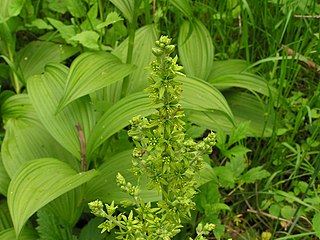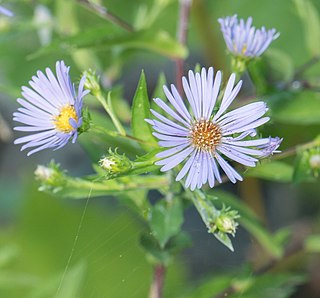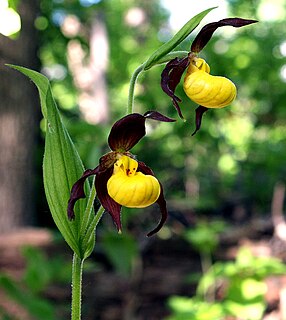
Asimina is a genus of small trees or shrubs described as a genus in 1763.

Trillium is a genus of about fifty flowering plant species in the family Melanthiaceae. Trillium species are native to temperate regions of North America and Asia, with the greatest diversity of species found in the southern Appalachian Mountains in the southeastern United States.

Hepatica is a genus of herbaceous perennials in the buttercup family, native to central and northern Europe, Asia and eastern North America. Some botanists include Hepatica within a wider interpretation of Anemone.

Melanthieae is a tribe of flowering plants within the family Melanthiaceae. Molecular phylogenetic studies in the 21st century have resulted in a large-scale reassignment of many of its species to different genera; in particular the genus Zigadenus (deathcamases) has been restricted to a single species, Zigadenus glaberrimus. Plants contain alkaloids, making them unpalatable to grazing animals; many are very poisonous to both animals and humans.

Clintonia is a genus of flowering plants in the lily family Liliaceae. Plants of the genus are distributed across the temperate regions of North America and eastern Asia, in the mesic understory of deciduous or coniferous forests. The genus, first described by Constantine Samuel Rafinesque in 1818, was named for DeWitt Clinton (1769–1828), a naturalist and politician from the U.S. state of New York. For this reason, plants of the genus are commonly known as Clinton's lily. The common name bluebead refer to the distinctive fruit of members of the genus. Since fruit color varies somewhat across species, the common name bead lily is used as well.

Veratrum viride, known as Indian poke, corn-lily, Indian hellebore, false hellebore, green false hellebore, or giant false-helleborine, is a species of Veratrum native to eastern and western North America. It is extremely toxic, and is considered a pest plant by farmers with livestock. The species has acquired a large number of other common names within its native range, including American false hellebore, American white hellebore, bear corn, big hellebore, corn lily, devils bite, duck retten, itch-weed, itchweed, poor Annie, blue hellebore and tickleweed.

Amianthium is a North American genus of perennial plants growing from bulbs. It contains the single known species Amianthium muscitoxicum, known in English as fly poison from a literal translation of the Latin epithet muscitoxicum, and is noted for its pretty flowers and its toxic alkaloid content. While all parts of the plant are poisonous, the bulb is particularly toxic. The scientific epithet was given to it by Thomas Walter when he published his Flora Caroliniana in 1788.

Eriophorum is a genus of flowering plants in the family Cyperaceae, the sedge family. They are found throughout the arctic, subarctic, and temperate portions of the Northern Hemisphere in acid bog habitats, being particularly abundant in Arctic tundra regions.

Illicium is a genus of flowering plants treated as part of the family Schisandraceae, or alternately as the sole genus of the Illiciaceae. It has a disjunct distribution, with most species native to eastern Asia and several in parts of North America, including the southeastern United States, Mexico, and the Caribbean. General common names include star anise and anisetree. The genus name comes from the Latin illicere.

Veratrum is a genus of flowering plants in the family Melanthiaceae. It occurs in damp habitats across much of temperate and subarctic Europe, Asia, and North America.

Symphyotrichum puniceum, commonly known as purplestem aster, red-stalk aster, red-stemmed aster, red-stem aster, or swamp aster, is a perennial herb native to eastern North America. It has also been called early purple aster and meadow scabish.

Cypripedium parviflorum, commonly known as yellow lady's slipper or moccasin flower, is a lady's slipper orchid native to North America. It is widespread, ranging from Alaska south to Arizona and Georgia.

Trillium albidum, also known as giant white wakerobin, white toadshade, and sweet trillium, is a species of flowering plant in the family Melanthiaceae. The species is endemic to the western United States, ranging from west central California through Oregon to Washington. It is found in diverse habitats, on the moist slopes of mixed deciduous-coniferous forests, among shrubs and thickets, and along stream banks and river beds.

Veratrum hybridum is a species of flowering plant in the Melanthiaceae known by the common names slender bunchflower and crisped bunchflower. Many publications use the synonyms Melanthium latifolium and Veratrum latifolium, but the "hybridum" epithet is 9 years older than the "latifolium," so Veratrum hybridum is now the accepted name.

Anchistea is a genus of leptosporangiate ferns in the family Blechnaceae. It has only one species, Anchistea virginica the Virginia chain fern, which has long creeping, scaly, underground stems or rhizomes giving rise to tall widely separated, deciduous, single leaves. In contrast, the leaves of Osmundastrum cinnamomeum, which can be mistaken for A. virginica, grow in a group from a crown. Also in contrast to O. cinnamomeum the leaves are monomorphic without distinct fertile fronds. The lower petiole or stipe is dark purple to black, shiny and swollen, the upper rachis is dull green. The leaf blade is green and lanceolate, composed of 12 to 23 paired, alternate pinnatifid pinnae. The pinnae are subdivided into 15 to 20 paired segments that are ovate to oblong. The lower rachis is naked for about half its length. The sori or spore-producing bodies are found on the underside of the pinnae and are long and form a double row which outlines the major veins of the pinnae. In common with all ferns, A. virginica exhibits a gametophyte stage in its life cycle and develops a haploid reproductive prothallus as an independent plant. The spores are produced in red-brown sori which line the spaces (areolae) between the costa and costules. Further photographs can be found at the Connecticut Botanical Society and Ontario Ferns websites.
Melanthium woodii, common names Wood's bunchflower or Ozark bunch-flower, is a species formerly known as Veratrum woodii. It is native to the central and southeastern parts of the United States, from Arkansas, Florida, Georgia, Illinois, Indiana, Iowa, Kentucky, Missouri, North Carolina, Ohio, Oklahoma and Tennessee. It can be found in forested areas at elevations less than 800 m.

Triadenum fraseri known as bog St. John's wort, Fraser's St. John's wort, and Fraser's marsh St. John's wort, is a perennial flowering plant in the family Hypericaceae that is grows in wetlands of the northeastern and northcentral United States and lower Canada. It is named after John Fraser (1750–1811), a Scottish botanist and widely travelled plant collector.

Carex woodii, known as pretty sedge, is a species of sedge native to North America.

Hypericum virginicum, the marsh St. Johns-wort or Virginia marsh St. Johnswort, is a species of flowering plant in the family Hypericaceae. It is native to the central and eastern United States and eastern Canada.

Pseudolycopodiella caroliniana, known as slender bog club-moss, is a species of lycophyte in the family Lycopodiaceae. The genus Pseudolycopodiella is accepted in the Flora of North America and the Pteridophyte Phylogeny Group classification of 2016, but not in other classifications, which submerge the genus in Lycopodiella. The species has a discontinuous distribution, being native to the eastern United States and to parts of eastern Asia.


















